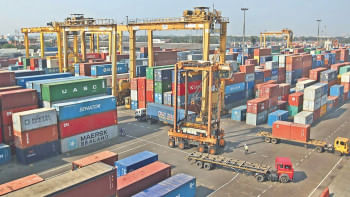Tackling joblessness requires thinking out of the box

The issues currently dominating economic discussions in Bangladesh are stagnant growth, high inflation, reduced investments, and apprehensions about a floating exchange rate, among others. But one particular topic that often does not feature in debates surrounding the country's economic challenges is joblessness, despite the alarming level it has reached of late. And this has important economic, social and political implications.
Today, about 27.4 lakh people in Bangladesh are jobless and the unemployment rate in the country stands at 4.63 percent. During the first half of the outgoing fiscal year, more than 20 lakh people lost their jobs. It goes without saying that because of the way the phenomenon of unemployment is defined and enumerated, the official unemployment figures are underestimations of the real situation on the ground, and thus, the actual joblessness in Bangladesh is much higher than the official figure. For example, the official unemployment among women was reported to be 3.6 percent, but the real figure has been estimated and reported at 9.7 percent.
Several factors have contributed to the high joblessness. First is the sluggish economic growth. Bangladesh's economy has grown by 3.97 percent during the current fiscal year. Excluding the pandemic years, this is the slowest GDP growth rate that the country experienced over the past 34 years. The agricultural sector grew by 1.79 percent during the current fiscal year, nearly half of the 3.30 percent growth rate the sector enjoyed during FY2023-24. The agricultural sector faced significant challenges, primarily due to severe flooding. The service sector growth during the same period dropped from 5.09 to 4.51 percent because of shrinking consumer demand, reduced industrial production, and declining exports in some sectors. As the agricultural and service sectors account for 82.6 percent of the total employment in Bangladesh's economy, the decline in the growth rate of these sectors contributed to the increasing joblessness in the country.
The second factor which has accelerated joblessness in the economy is inadequate investment and slow investment growth. The total investment-GDP ratio in Bangladesh has fallen from 30.7 percent last fiscal year to 29.38 percent this year. The corresponding figures for private investments are 23.96 percent and 22.48 percent respectively. The reasons for declines in private investments are uncertainties in the economy, political instability, high inflation, tighter monetary policy, alarming law and order situation, labour unrest, and absence of necessary reforms in various sectors of the economy. For example, in the absence of a clear election roadmap, investors—both local and foreign—are hesitating to come forward to invest more in the Bangladesh economy. Foreign direct investments (FDIs) are also not forthcoming. These are dampening both new investments and reinvestments necessary for running the existing plants. As a result, employment creation has been decelerated.
High inflation is also a deterring factor and negatively impacts investments in three ways: first, by raising the cost of economic operations; second, by reducing consumer demand; and lastly, by making credit difficult to get. Since inflation made the factors of production costly, investors were discouraged from investing. Similarly, on the demand side, as inflation reduced consumer demands, the incentive for investors to invest went down too. Bangladesh Bank pursued a tighter monetary policy by maintaining higher bank rates in order to tackle high inflation in the economy. All these have had dampening effects on investments. With high inflation, there were lower investments and fewer business expansions. This ultimately led to fewer job creation and higher joblessness in the economy.
Lower investments in the economy, accelerated by economic instabilities and political uncertainties led to insufficient and shrinking job opportunities and also reduced entrepreneurial opportunities. In addition, the skill mismatch in the labour markets resulted in increased unemployment. In Bangladesh, the educational system has not been producing graduates with the skills required by emerging labour markets. For example, computer and digital education and experience in this field are now a must in the labour market. But many people lack computer and digital literacy and thus cannot find jobs. The quality of education is also a factor. Institutional factors like corruption, non-adherence to the rule of meritocracy have also contributed to joblessness in the economy.
The fundamental question, then, is what needs to be done to create employment in Bangladesh. Measures should be taken both at the policy and institutional level. At the policy level, the first thing that is needed is thinking out of the box. The pursuance of traditional vocational education and training would do some good, but it is inadequate to tackle the challenge of joblessness in today's world. The future world of work is changing fast with digital revolution, where traditional ideas of job creation have become obsolete. Both the content and the modus operandi of the future world of work would require new skill sets and different work organisation and processes.
To do that, first, an assessment profile of the kind of skills currently being developed in Bangladesh must be prepared, identifying areas of opportunities and deficits. In preparing such a mapping, the current and upcoming human resource demands of domestic entrepreneurs must be kept in mind. A comprehensive list of future job opportunities and the skills required for those jobs should be prepared. In that context, the new realities of digital revolution must be kept in mind. This assessment would also treat skilled migration as a national priority. Combining these three, a job mapping plan for the country should be formulated and that plan must be made consistent with the overall economic plan of the country. The existing National Employment Policy 2022 needs to be comprehensively revised and updated to reflect the prospects, needs and constraints of the current labour market and the future nature of work.
Second, the educational structure of the country including academic programmes, syllabuses, teaching and learning methods, and educational facilities must be evaluated. The objective of this assessment would be to determine whether the country's current educational system can meet its human resource demand as outlined in the job mapping plan. In light of this, the entire educational system must be overhauled, where science, technology, engineering and mathematics (STEM) would be at the core, along with information technology and artificial intelligence. In developing such an educational structure, the focus should be on the history, culture and heritage of Bangladesh. However, the structure should also draw on the experiences of achievements of other countries. Such an overhaul is essential for tackling the skill mismatch in the economy. The system should produce people with skills, and not just with certificates.
Third, in order to upgrade work skills continuously, necessary training must be pursued to ensure that the knowledge is up-to-date, modern, timely and relevant. Specific programmes may be undertaken to improve skills. These include strengthening industry-academic partnerships, developing on-the-job mentorship, organising affordable in-house training, offering skill-based incentives and bonuses, providing language training programmes, utilising government skill development programmes, and partnering with local NGOs and training providers. Universities must be involved in research and innovation.
Even though the issue of joblessness is not discussed at par with other challenges of the economy, it remains the elephant in the room. The issue of joblessness should be at the centre of the growth strategy so that Bangladesh's economy may pursue an employment-led growth, rather than a growth-led employment strategy. The central bank may also think of dual targets involving both inflation and employment. When it comes to tackling joblessness, we have to think out of the box as yesterday's strategies would not be able to solve tomorrow's problems.
Selim Jahan is former director of the Human Development Report Office under the United Nations Development Programme (UNDP) and lead author of the Human Development Report.
Views expressed in this article are the author's own.
Follow The Daily Star Opinion on Facebook for the latest opinions, commentaries and analyses by experts and professionals. To contribute your article or letter to The Daily Star Opinion, see our guidelines for submission.

 For all latest news, follow The Daily Star's Google News channel.
For all latest news, follow The Daily Star's Google News channel. 





Comments